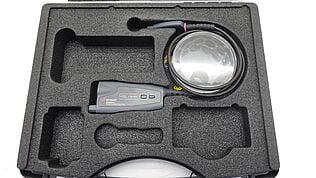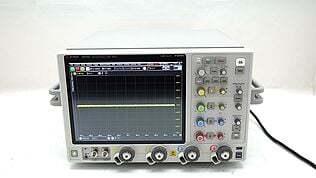- Introduction
- What is a Pulse?
- Understanding Pulse Width
- Parameters of a Pulse
- Why Pulse Width Matters
- Signal Integrity in High-Speed Digital Communication
- Pulse Modulation Techniques: PWM and PPM
- Component Testing: Knowing Your Circuit Inside Out
- Methods for Measuring Pulse Width
- Direct Time Measurement: The Manual Method
- Automated Measurement: The High-Tech Approach
- Statistical Methods: The Data-Driven Approach
- Factors Affecting Pulse Width Accuracy
- Examples of Pulse Width in Action
- PWM Motor Control: A Delicate Balance
- High-Speed Data Transmission: Precision in Fiber Optics
- Conclusion
- Whenever You’re Ready, Here Are 5 Ways We Can Help You
Did you know that in high-speed digital communication, a tiny variation in pulse width can cause significant signal integrity issues?
Understanding pulse width is crucial for electrical engineers, especially those who frequently use oscilloscopes for debugging circuits, evaluating signal integrity, or analyzing communication protocols.
In this comprehensive guide, we delve into the concept of pulse width as it relates to oscilloscopes, the key parameters affecting it, and why it is vital for high-quality signal analysis.
What is a Pulse?
Before diving into pulse width, let's clarify what constitutes a pulse in electrical engineering. A pulse is a change in a signal from a low to a high state (or vice versa), followed by a rapid return to the initial state after a specific period.
Understanding Pulse Width
Pulse width, usually denoted as PW, is the time duration for which the pulse remains at its maximum amplitude or it measures the width of the pulse at its half-maximum amplitude, effectively giving us the "width" of the pulse in the time domain.
Parameters of a Pulse
A typical pulse comprises the following parameters:
- Amplitude: The maximum voltage level attained during the pulse
- Rise time: Time taken to transition from the low to high state
- Fall time: Time taken to transition from the high to low state
- Pulse width: The duration for which the pulse remains in the high state
| Key Takeaway |
|---|
| Understanding and accurately measuring pulse width is critical for ensuring optimal system performance and reliability in various engineering applications, from motor control to high-speed data transmission. |
Ready to Find The Perfect Oscilloscope?
Why Pulse Width Matters
The importance of pulse width in oscilloscopic measurements and analysis stretches across multiple domains of electrical engineering. Let's delve into each crucial area in more detail.
Signal Integrity in High-Speed Digital Communication
Timing Skew and Data Loss
In high-speed digital circuits, even nanoseconds matter. Variations in pulse width can introduce timing skew, affecting the relative arrival times of data streams in parallel systems. This skew can lead to data misalignment, causing incorrect readings or even data loss.
Eye Diagram Testing
Engineers often use eye diagrams to assess signal integrity in high-speed communications. In these diagrams, inconsistent pulse widths can reduce the eye opening, making it harder to distinguish between logical 1s and 0s. This leads to a higher bit error rate, compromising the integrity of the data transmission.
Phase Noise and Jitter
Changes in pulse width can also contribute to phase noise and timing jitter, further degrading signal quality. Accurate pulse width measurement helps in diagnosing these issues, enabling effective troubleshooting and system optimization.
Pulse Modulation Techniques: PWM and PPM
Encoding and Decoding Efficiency
In pulse width modulation (PWM), the pulse width directly encodes the analog signal level. A slight deviation in the pulse width can lead to a misrepresentation of the encoded signal. Similarly, in pulse position modulation (PPM), any alteration in pulse width may cause decoding errors.
Power Efficiency and Signal-to-Noise Ratio
Precise control of pulse width in PWM systems also influences power efficiency, especially in applications like motor control and LED dimming. Similarly, accurate pulse widths in PPM systems help maintain a high signal-to-noise ratio, crucial for applications like remote sensing and optical communications.
Component Testing: Knowing Your Circuit Inside Out
Filters
Understanding the pulse width allows you to predict how a filter will behave, especially regarding its transient response and bandwidth. This knowledge is critical for applications like audio processing and signal conditioning.
Amplifiers
Amplifiers have slew rates that limit their ability to respond to rapid changes in input signals. Knowing the pulse width helps you choose an amplifier that can faithfully reproduce the signal without distortions.
Transistors and Switching Elements
In digital circuits, transistors serve as switching elements. The time the transistor takes to switch from an 'off' to 'on' state and vice versa depends on the pulse width. Incorrect pulse widths can lead to incomplete switching, causing logic errors and increased power consumption.
Understanding and accurately measuring pulse width serves as a linchpin for ensuring optimal system performance, be it in signal integrity, modulation techniques, or component selection and testing. Given its far-reaching implications, it remains a parameter that no electrical engineer should overlook.

Methods for Measuring Pulse Width
Measuring pulse width isn't just a one-size-fits-all process. Depending on your application and the level of accuracy you need, different approaches might be more suitable.
Here, we dig deeper into three popular methods for measuring pulse width using an oscilloscope.
Direct Time Measurement: The Manual Method
Steps Involved
- Trigger the oscilloscope to display the pulse signal on the screen.
- Manually move the cursors to the rising and falling edges of the pulse.
- Read the time difference between the cursors, which gives you the pulse width.
Advantages
- User control: This method allows for human judgement, especially useful when the pulse shape is irregular or when noise affects the signal.
- Flexibility: You can choose the exact points for measurement, allowing you to tailor your approach based on the specific aspect you're studying.
Limitations
- Time-consuming: This method can be slow, particularly when you need to measure multiple pulses.
- Subject to human error: Manual measurements are prone to errors due to cursor misplacement or misreading.
Automated Measurement: The High-Tech Approach
Modern oscilloscopes often come with built-in functions to measure pulse width. Simply select the 'Pulse Width' measurement from the menu, and the oscilloscope will compute it for you.
Advantages
- Speed: Automated measurements are incredibly fast, almost instantaneous.
- Consistency: Automated systems deliver highly repeatable results, eliminating human error.
Limitations
- Cost: These features are usually available in higher-end oscilloscopes, making them less accessible for those on a budget.
- Complexity: Some oscilloscopes offer numerous settings and customization options, which can overwhelm inexperienced users.
Statistical Methods: The Data-Driven Approach
A histogram function can display the distribution of measured pulse widths over time, providing a statistical view of pulse width variations.
Advantages
- Comprehensive analysis: Histograms can reveal outliers or trends that might not be immediately obvious from single measurements.
- Quality assurance: For mass production or quality control, statistical methods provide a robust way to validate the consistency of signal behavior.
Limitations
- Data overload: Analyzing statistical data requires a thorough understanding of statistical methods and may be overwhelming for some applications.
- Time requirement: Collecting sufficient data for statistical analysis can be time-consuming, especially for low-frequency signals.
Each method has its own set of advantages and limitations, and the choice of method depends on the specific requirements of your application. Whether you opt for manual, automated, or statistical methods, understanding the intricacies of each can empower you to make more informed decisions in your engineering projects.
Factors Affecting Pulse Width Accuracy
| Factor | Impact on Pulse Width Measurement | Solution |
| Bandwidth Limitation | Reduced resolution and accuracy | Use an oscilloscope with a higher bandwidth |
| Sampling Rate | Aliasing and distortion of pulse shape | Choose an oscilloscope with a high sampling rate |
| Trigger Jitter | Introduction of timing errors | Utilize advanced triggering options |
| Probe Impact | Signal attenuation and noise | Use high-quality, low-impact probes |
Examples of Pulse Width in Action
Pulse width has real-world applications that directly influence the performance and reliability of various systems.
Here are two key examples to illustrate its significance: PWM Motor Control and High-Speed Data Transmission in Fiber Optics.
PWM Motor Control: A Delicate Balance
In applications that use Pulse Width Modulation (PWM) to control DC motor speeds, even a slight variation in pulse width can lead to noticeable speed differences. For instance, a mere 1% change in pulse width can result in a significant speed change, affecting the overall performance of the system.
Key Takeaways
- Energy efficiency: Accurate control of pulse width is essential for optimizing motor performance and minimizing energy consumption.
- System performance: In automation and robotics, where precise motor control is crucial, a minor deviation in pulse width can affect the system's functionality.
High-Speed Data Transmission: Precision in Fiber Optics
Fiber optic communication is another arena where pulse width plays a vital role. In this system, lasers generate pulses to represent digital data (1s and 0s) as they travel through optical fibers. Maintaining precise pulse widths ensures that the receiving end accurately decodes these digital bits, preserving the integrity of transmitted data.
Key Takeaways
- Reduced error rates: Precise pulse widths contribute to a lower bit error rate, a key metric in assessing the quality of data transmission.
- System reliability: Consistent pulse widths lead to more reliable data transmission, enhancing the overall reliability of communication systems.
Both examples underline the practical importance of understanding and controlling pulse width. Whether you're tuning a motor control system or ensuring reliable data transmission in high-speed networks, keeping a close eye on pulse width is critical for success.
Certified Refurbished Oscilloscopes On Sale Now
Select up to 3 instruments to compare
Enable Notifications
In order to use this feature, you need to enable notifications.
Manage notification preferences
Conclusion
In the complex world of electrical engineering, the concept of pulse width is more than just a textbook term—it's a crucial parameter that influences everything from signal integrity to system performance.
Whether you're fine-tuning a motor control system using PWM or ensuring the reliability of high-speed fiber optic communications, understanding and accurately measuring pulse width can significantly impact your project's success.
You understand the importance of pulse width; now it's time to ensure you have the right tools for precise measurements.
Keysight Used Equipment Store offers premium used oscilloscopes, network analyzers, waveform generators, and multimeters that can help you excel in your engineering projects.

Whenever You’re Ready, Here Are 5 Ways We Can Help You
- Browse our Premium Used Oscilloscopes.
- Call tech support US: +1 800 829-4444
Press #, then 2. Hours: 7 am – 5 pm MT, Mon– Fri - Talk to our sales support team by clicking the icon (bottom right corner) on every offer page
- Create an account to get price alerts and access to exclusive waitlists.
- Talk to your account manager about your specific needs.












































